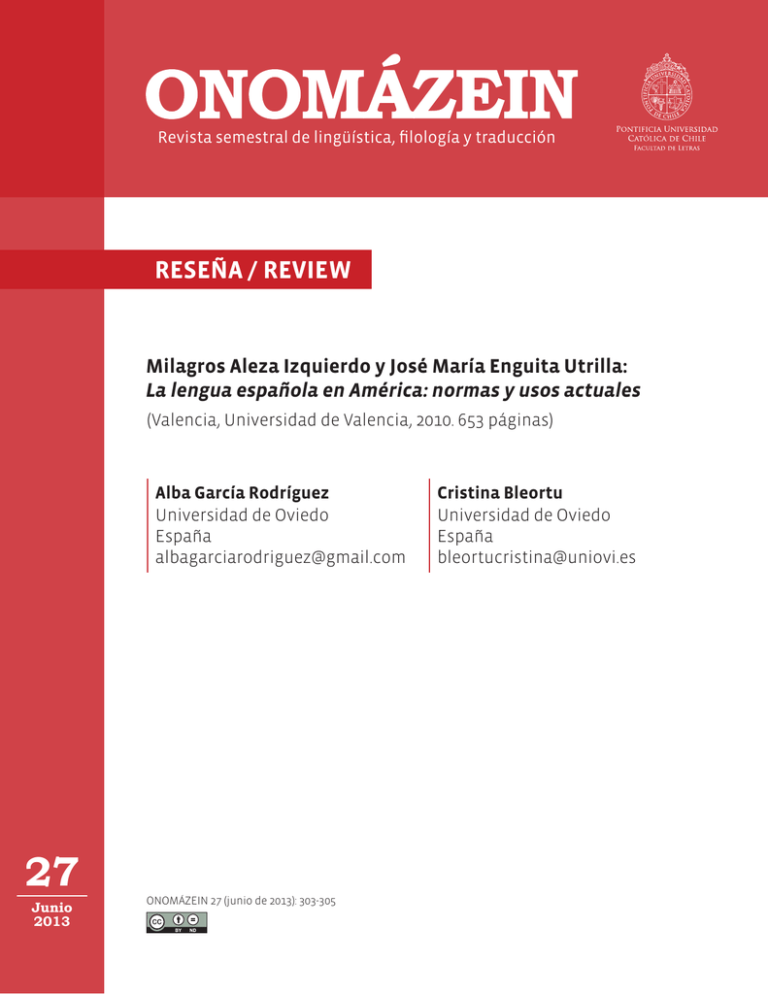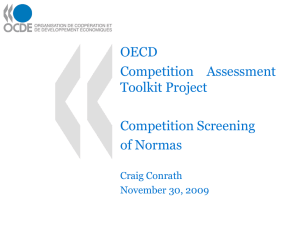reseña / review
Anuncio

Revista semestral de lingüística, filología y traducción RESEÑA / REVIEW Milagros Aleza Izquierdo y José María Enguita Utrilla: La lengua española en América: normas y usos actuales (Valencia, Universidad de Valencia, 2010. 653 páginas) Alba García Rodríguez Universidad de Oviedo España albagarciarodriguez@gmail.com 27 Junio 2013 ONOMÁZEIN 27 (junio de 2013): 303-305 Cristina Bleortu Universidad de Oviedo España bleortucristina@uniovi.es ONOMÁZEIN 27 (junio de 2013): 303 - 305 Alba García Rodríguez y Cristina Bleortu Milagros Aleza Izquierdo y José María Enguita Utrilla: La lengua española en América: normas y usos actuales 304 After the publication of El español de América: aproximación sincrónica (2002), professors M. Aleza (University of Valencia) and J. M. Enguita (University of Zaragoza) teamed up to coordinate the volume La lengua española en América: normas y usos actuales. It should be noted that this is a book with free online access. exclusive of certain areas, bearing in mind the situation of contact between Spanish and Amerindian languages. This is a complete chapter in which the author describes the main uses and values of the different Spanish grammatical categories: pronouns, verbs, verbal periphrasis, nouns, adverbs, etc. Adopting a synchronic perspective, the authors provide detailed information about a wide variety of phonetic, grammatical, lexical, lexicographical and pragmatic aspects. These linguistic aspects affect the dialectal varieties that form what is known as “American Spanish”. The result is a comprehensive book for researchers, teachers and scholars of American Spanish. The 4th Chapter, a contribution by M. Calderón, keeps the focus on the study of different linguistic formulae of approach. This is a detailed analysis from its origin to its current uses. In order to show this, the author explores three basic concepts: tuteo, voseo and ustedeo. As far as the structure of the book is concerned, it should be noted that this is an extensive and selective work which consists of nine theoretical chapters and three that approach the practical side of theory. Furthermore, this book contains papers written by the coordinators of the volume (M. Aleza and J. M. Enguita) and other works written by important scholars specialised in Spanish spoken in America. The Introduction (Chapter 1) sets the scene by exploring general considerations about the genesis and development of the American varieties. Besides, the authors try to define key concepts that are a bit controversial, such as “American Spanish”, “Atlantic Spanish” or “panHispanic standard”. In Chapter 2, Dr M. Aleza compiles the description of the sounds of different American Spanish dialects. In this part of the book, the author analyzes various phonetic phenomena affecting both consonants (yeísmo, rehilamiento, seseo, ceceo, neutralization of the liquids consonants, etc.) and vowels (diphthongization of hiatus, vowel reduction, vowel lengthening, etc.). In the next chapter, Dr M. Aleza studies the main grammatical aspects, both generic and M. Albelda and A. Briz’s study put the reader in touch with discourse analysis in Chapter 5, with particular attention to two very important pragmatic aspects: mitigation and verbal politeness. Moreover, the authors accompany their theoretical synthesis with data showing the resources and the attenuated frequencies in some corpora of Peninsular and American Spanish. Lexical units are discussed in Chapter 6, where J. M. Enguita makes a detailed study about the vocabulary of the American varieties and their differences with European Spanish. Furthermore, various processes of new words formation are analysed, which are very dynamic in American Spanish. Meanwhile, Chapter 7 consists of two parts: the first one enquires in some issues related to the development of American lexicography. On the second part, D. Giménez collects a repertoire of various dictionaries according to criteria such as type and geography. The contact of Spanish with other languages is focused extensively in two chapters: Chapter 8 (J. M. Enguita and R. Navarro) that gives an overview of the coexistence of Spanish and Amerindian languages, and Chapter 9 where A. Torres analyses the development of Spanish in the United States, referring to the linguistic varieties of ONOMÁZEIN 27 (junio de 2013): 303 - 305 Alba García Rodríguez y Cristina Bleortu Milagros Aleza Izquierdo y José María Enguita Utrilla: La lengua española en América: normas y usos actuales the Latin American groups in North America. The second part of the book presents a more practical nature, reinforcing many of the points presented in the first section. It includes the work of Dr F. Fernández de Castro (Chapter 10) with a complete anthology of phonetic texts with their comments, which are very useful for both researchers and teachers. Meanwhile, Chapter 11 (E. España) contains grammar exercises based on the theoretical contents of Chapter 3. Finally, within this second section, A. Torres devotes Chapter 12 to the topic of Spanglish through different exercises related to the concepts that the same author explores in Chapter 9. At the end of the book, there is a detailed bibliography of each chapter and a side note providing information about the various authors who work in this generic volume. In conclusion, this book is a valuable contribution to the field of study of American Spanish. Moreover, thanks to the cooperation of different authors, many linguistic aspects are analysed, focusing on different dialects and not one in particular. However, methodological unity is not lost over the pages, making a complete, varied and, also, coherent book. This fact is especially appreciated because of the traditional disparity within the investigations about the American Spanish varieties. 305
